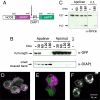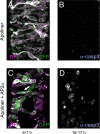A fluorescent reporter of caspase activity for live imaging
- PMID: 18779587
- PMCID: PMC2544551
- DOI: 10.1073/pnas.0806983105
A fluorescent reporter of caspase activity for live imaging
Abstract
There is a growing interest in the mechanisms that control the apoptosis cascade during development and adult life. To investigate the regulatory events that trigger apoptosis in whole tissues, we have devised a genetically encoded caspase sensor that can be detected in live and fixed tissue by standard confocal microscopy. The sensor comprises two fluorophores, mRFP, monomeric red fluorescent protein (mRFP) and enhanced green fluorescent protein (eGFP), that are linked by an efficient and specific caspase-sensitive site. Upon caspase activation, the sensor is cleaved and eGFP translocates to the nucleus, leaving mRFP at membranes. This is detected before other markers of apoptosis, including anti-cleaved caspase 3 immunoreactivity. Moreover, the sensor does not perturb normal developmental apoptosis and is specific, as cleavage does not occur in Drosophila embryos that are unable to activate the apoptotic cascade. Importantly, dying cells can be recognized in live embryos, thus opening the way for in vivo imaging. As expected from the high conservation of caspases, it is also cleaved in dying cells of chick embryos. It is therefore likely to be generally useful to track the spatiotemporal pattern of caspase activity in a variety of species.
Conflict of interest statement
The authors declare no conflict of interest.
Figures





References
-
- Cashio P, Lee TV, Bergmann A. Genetic control of programmed cell death in Drosophila melanogaster. Semin Cell Dev Biol. 2005;16:225–235. - PubMed
-
- Wang SL, et al. The Drosophila caspase inhibitor DIAP1 is essential for cell survival and is negatively regulated by HID. Cell. 1999;98:453–463. - PubMed
-
- Ditzel M, et al. Degradation of DIAP1 by the N-end rule pathway is essential for regulating apoptosis. Nat Cell Biol. 2003;5:467–473. - PubMed
-
- Miguel-Aliaga I, Thor S. Segment-specific prevention of pioneer neuron apoptosis by cell-autonomous, postmitotic Hox gene activity. Development. 2004;131:6093–6105. - PubMed
Publication types
MeSH terms
Substances
Grants and funding
LinkOut - more resources
Full Text Sources
Other Literature Sources
Molecular Biology Databases
Research Materials

